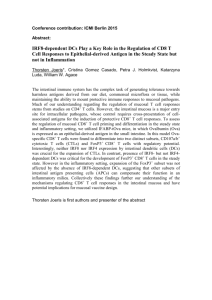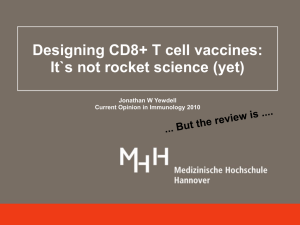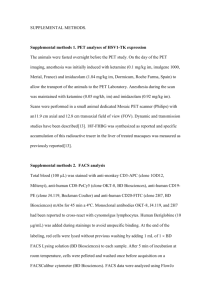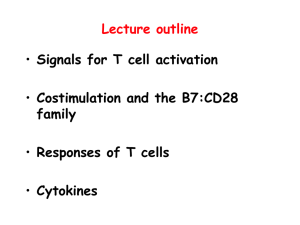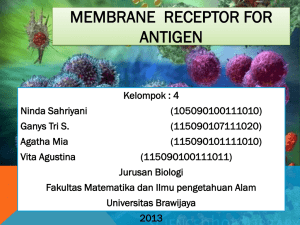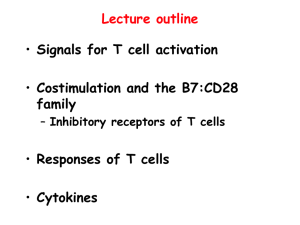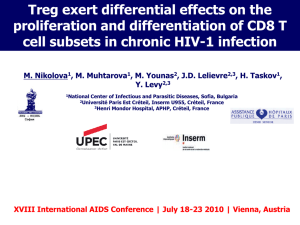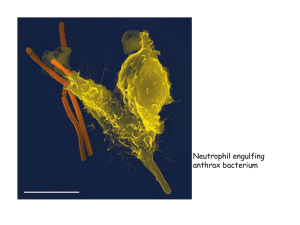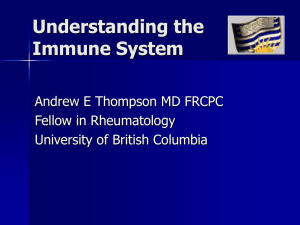attached document
advertisement
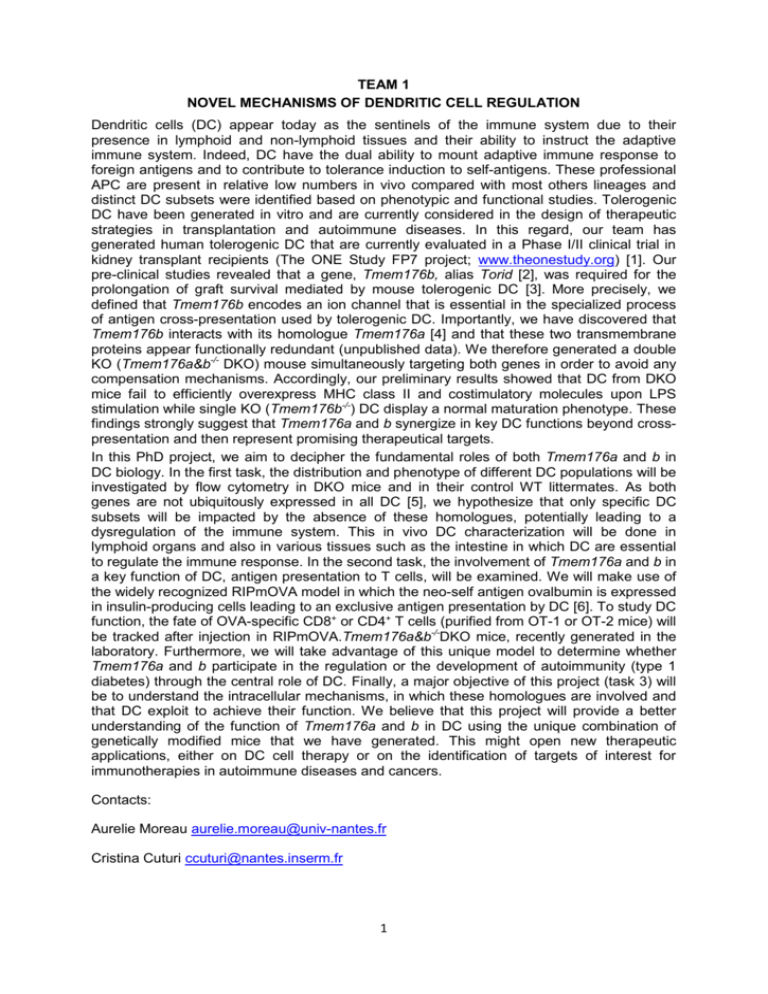
TEAM 1 NOVEL MECHANISMS OF DENDRITIC CELL REGULATION Dendritic cells (DC) appear today as the sentinels of the immune system due to their presence in lymphoid and non-lymphoid tissues and their ability to instruct the adaptive immune system. Indeed, DC have the dual ability to mount adaptive immune response to foreign antigens and to contribute to tolerance induction to self-antigens. These professional APC are present in relative low numbers in vivo compared with most others lineages and distinct DC subsets were identified based on phenotypic and functional studies. Tolerogenic DC have been generated in vitro and are currently considered in the design of therapeutic strategies in transplantation and autoimmune diseases. In this regard, our team has generated human tolerogenic DC that are currently evaluated in a Phase I/II clinical trial in kidney transplant recipients (The ONE Study FP7 project; www.theonestudy.org) [1]. Our pre-clinical studies revealed that a gene, Tmem176b, alias Torid [2], was required for the prolongation of graft survival mediated by mouse tolerogenic DC [3]. More precisely, we defined that Tmem176b encodes an ion channel that is essential in the specialized process of antigen cross-presentation used by tolerogenic DC. Importantly, we have discovered that Tmem176b interacts with its homologue Tmem176a [4] and that these two transmembrane proteins appear functionally redundant (unpublished data). We therefore generated a double KO (Tmem176a&b-/- DKO) mouse simultaneously targeting both genes in order to avoid any compensation mechanisms. Accordingly, our preliminary results showed that DC from DKO mice fail to efficiently overexpress MHC class II and costimulatory molecules upon LPS stimulation while single KO (Tmem176b-/-) DC display a normal maturation phenotype. These findings strongly suggest that Tmem176a and b synergize in key DC functions beyond crosspresentation and then represent promising therapeutical targets. In this PhD project, we aim to decipher the fundamental roles of both Tmem176a and b in DC biology. In the first task, the distribution and phenotype of different DC populations will be investigated by flow cytometry in DKO mice and in their control WT littermates. As both genes are not ubiquitously expressed in all DC [5], we hypothesize that only specific DC subsets will be impacted by the absence of these homologues, potentially leading to a dysregulation of the immune system. This in vivo DC characterization will be done in lymphoid organs and also in various tissues such as the intestine in which DC are essential to regulate the immune response. In the second task, the involvement of Tmem176a and b in a key function of DC, antigen presentation to T cells, will be examined. We will make use of the widely recognized RIPmOVA model in which the neo-self antigen ovalbumin is expressed in insulin-producing cells leading to an exclusive antigen presentation by DC [6]. To study DC function, the fate of OVA-specific CD8+ or CD4+ T cells (purified from OT-1 or OT-2 mice) will be tracked after injection in RIPmOVA.Tmem176a&b-/-DKO mice, recently generated in the laboratory. Furthermore, we will take advantage of this unique model to determine whether Tmem176a and b participate in the regulation or the development of autoimmunity (type 1 diabetes) through the central role of DC. Finally, a major objective of this project (task 3) will be to understand the intracellular mechanisms, in which these homologues are involved and that DC exploit to achieve their function. We believe that this project will provide a better understanding of the function of Tmem176a and b in DC using the unique combination of genetically modified mice that we have generated. This might open new therapeutic applications, either on DC cell therapy or on the identification of targets of interest for immunotherapies in autoimmune diseases and cancers. Contacts: Aurelie Moreau aurelie.moreau@univ-nantes.fr Cristina Cuturi ccuturi@nantes.inserm.fr 1 1. 2. 3. 4. 5. 6. 7. Moreau, A., et al., Tolerogenic dendritic cells and negative vaccination in transplantation: from rodents to clinical trials. Front Immunol., 2012. 3:218.(doi): p. 10.3389/fimmu.2012.00218. eCollection 2012. Louvet, C., et al., Identification of a new member of the CD20/FcepsilonRIbeta family overexpressed in tolerated allografts. Am J Transplant., 2005. 5(9): p. 2143-53. Segovia, M., et al., Autologous dendritic cells prolong allograft survival through Tmem176bdependent antigen cross-presentation. Am J Transplant., 2014. 14(5): p. 1021-31. doi: 10.1111/ajt.12708. Epub 2014 Apr 14. Condamine, T., et al., Tmem176B and Tmem176A are associated with the immature state of dendritic cells. J Leukoc Biol., 2010. 88(3): p. 507-15. doi: 10.1189/jlb.1109738. Epub 2010 May 25. Jaitin, D.A., et al., Massively parallel single-cell RNA-seq for marker-free decomposition of tissues into cell types. Science., 2014. 343(6172): p. 776-9. doi: 10.1126/science.1247651. Harbers, S.O., et al., Antibody-enhanced cross-presentation of self antigen breaks T cell tolerance. J Clin Invest., 2007. 117(5): p. 1361-9. Epub 2007 Apr 19. Godet, Y., et al., MELOE-1 is a new antigen overexpressed in melanomas and involved in adoptive T cell transfer efficiency. J Exp Med, 2008. 205(11): p. 2673-82. 2 Team 2 Title: New cell therapy in transplantation with engineered hiPSC-derived T-cells Immunotherapy is an innovative field that is bringing new therapeutic opportunities, especially in cancer treatment or as anti-rejection agent for transplanted patients. In transplantation, the aim is to use regulatory T cells to dampen the immune response causing graft rejection [7, 8]. Obstacles for the development of T cell therapies are the standardization, cost and time of generation of these cells. Availability of unlimited numbers of well characterized and standardized origin of T cells would be a major achievement. We have shown in a rat model of tolerance that indefinite survival of grafts was dependent on TCRbiased CD8+CD45RClow Tregs [9, 10]. The global objective of this proposal is to generate tolerogenic antigen-specific T cells from human iPS cells. This procedure would allow unlimited availability of T cells for cellular therapy in transplantation. The candidate will develop differentiation protocols of human induced pluripotent stem cells (hiPSC) into T cells [11, 12]. The T cells will then be functionally evaluated. The candidate will, in collaboration with T. Nguyen and the CRISPR core facility of Nantes, develop genome-editing tools, in order to modify T cells immune function. hiPSC-derived T cells will then be available to be transduced with integrationcompetent lentiviral vectors expressing different TCRs. To this end, alpha and beta chains of the TCR from CD8+ Tregs, already available will be cloned in two different lentiviral vectors containing each sequence for different fluorescent markers to facs-sort double transduced cells to obtain hiPSC-derived Tregs. Such modified T-cells will then be evaluated for their capacity to inhibit allograft rejection in a humanized mice model of skin transplantation and graft-versus-host disease (through the Nantes Humanized Rodents platform). hiPSC-derived T cells will also be used to transfect transcription factors that will direct differentiation towards specific lineages (i.e. Foxp3 for Tregs). In conclusion, we expect to develop and offer a new source of antigen-specific therapeutic human T cells for transplantation and suitable for a range of other medical applications. Contact: Carole Guillonneau, PhD Carole.guillonneau@univ-nantes.fr Laurent David, PhD Laurent.david@univ-nantes.fr https://www.linkedin.com/profile/view?id=185991796&trk=nav_responsive_tab_profile 1. 2. 3. Lombardi, G., Sagoo, P., Scotta, C., Fazekasova, H., Smyth, L., Tsang, J., Afzali, B., and Lechler, R. 2011. Cell therapy to promote transplantation tolerance: a winning strategy? Immunotherapy 3:28-31. Guillonneau, C., Picarda, E., and Anegon, I. 2010. CD8+ regulatory T cells in solid organ transplantation. Curr Opin Organ Transplant 15:751-756. Guillonneau, C., Hill, M., Hubert, F.X., Chiffoleau, E., Herve, C., Li, X.L., Heslan, M., Usal, C., Tesson, L., Menoret, S., et al. 2007. CD40Ig treatment results in allograft acceptance mediated by CD8CD45RC T cells, IFN-gamma, and indoleamine 2,3-dioxygenase. J Clin Invest 117:1096-1106. 3 4. 5. 6. Picarda, E., Bezie, S., Venturi, V., Echasserieau, K., Merieau, E., Delhumeau, A., Renaudin, K., Brouard, S., Bernardeau, K., Anegon, I., et al. 2014. MHC-derived allopeptide activates TCRbiased CD8+ Tregs and suppresses organ rejection. J Clin Invest 124:2497-2512. David, L., and Polo, J.M. 2014. Phases of reprogramming. Stem Cell Res 12:754-761. Golipour, A., David, L., Liu, Y., Jayakumaran, G., Hirsch, C.L., Trcka, D., and Wrana, J.L. 2012. A late transition in somatic cell reprogramming requires regulators distinct from the pluripotency network. Cell Stem Cell 11:769-782. 4 Team 3 Contribution of the CD28-H/B7-H5 interaction compared to that of CD28/B7 in adaptive immunity. Some genes involved in immunity are lost during evolution in mice and rats but not in human and therefore classical murine models to decipher the role of such molecules cannot be use. To overcome this limitation, humanized mouse models are appealing and can be finely tuned to investigate new areas of immunology. Our team works for decades on developing a new selective CD28 antagonist which, in contrast to CD80/86 antagonist (CTLA4-Ig), blunts T cell costimulation while sparing CTLA-4 and PD-L1-dependent signals, and therefore promoting immune tolerance. The CD28/B7 family was recently extended with the CD28-H/B7-H5 T cell activation molecules. CD28-H is of particular interest since mouse and rat do not have the coding gene. CD28-H is constitutively express on naïve T cells, localized in the immunological synapse during T-cell stimulation and is eventually lost after repetitive stimulation. The investigation of a new member of CD28 family is challenging but the strong leadership of our team in the development of antibody and in the analysis of costimulation are strong assets for the success of such project. The aim of the PhD program is to decipher the role of CD28-H in adaptive immunity and to identify its singularity in regards to CD28. Within the 3 years of the PhD program, three specific aims will be addressed: Specific Aim 1: You will address the interplays between CD28-H, PD-1 and CD28 with commonly used immune stimulation tests in the presence or not of selective CD28-H blocking Ab or CD28-H activation molecules. Indeed, it has been recently shown by others that T cells infiltrating tumors are PD-1+CD28-H+. The role of CD28-H derived signals will be analyzed in settings in which CD28 is blocked using our selective CD28 antagonist. Proliferation, cytokine secretion and mRNA expression will be analyzed in CD4 and CD8 T cells, and in their subpopulations using either blood from healthy volunteers or cord-blood in which T cells are presumably naive. Similar experiment will be performed on CD4+CD28- and CD8+CD28- T cells. Specific Aim 2: Using our humanized mouse platform, you will decipher the role of CD28-H in vivo using already setup models such as Graph Versus Host diseases (GVHD), or human skin allograft rejection, in which naïve (CD28-H positive) T cells will be challenged in the presence or not of inhibitory Abs. To decipher the role of CD28-H in antigen recall responses a humanized mouse model of Delay Type Hypersensitivity (DTH) will be used. Specific Aim 3: Finally, you will take advantage of our biocollection of mRNA, frozen biopsies and serums harvested from baboons developing either tolerance or chronic rejection after kidney allograft transplantation or from baboons that underwent skin inflammation to confirm the role of CD28-H in clinically closer conditions. Similarly, you might implement you findings with the DIVAT biocoll samples. Understanding the role of CD28-H/B7-H5 interaction in adaptative immunity will very informative for our team project which focus on the inhibition of costimulatory molecules (See FR104 and Effimune for more details). 5 Keywords: immunology, humanized mice, costimulation, CD28, CD28-H Fabienne Haspot and Bernard Vanhove (HDR, head of the team) will mentored the PhD student. We encourage applications from excellent and motivated candidates with a diploma/Master Degree in Immunology. The excellence of the Master Degree’s results and the scientific quality of the candidate will be the main criteria of selection. Candidate’s profile: Knowledge required in immunology. Good skills in molecular biology, cell culture, flow cytometry and microscopy (eg, confocal) although those skills can be easily acquired during the PhD program. Experience with murine models will be appreciated. 6 Team 4 Project: LiTE CD8 function in MS: Linking TCR sequence of Expanded CD8 cells to their functional phenotype at the single cell level in central nervous system, CSF and blood of patients with Multiple Sclerosis. David LAPLAUD Inserm U1064, Neurology Dept, University Hospital, Nantes, France David.laplaud@univ-nantes.fr - Project rationale: MS is an inflammatory and demyelinating disease of the central nervous system (CNS) where CD8 T cells play a key role. We have recently demonstrated that overrepresented CD8 T cells found at lesion sites, thought to be driven by local cognate antigens, are the same overrepresented T cells found in the CSF of the same patients and represent up to 50% of the overrepresented blood CD8 T cells. Based on these previous results, the CSF and the blood can be used as a source of T cells involved in the disease process. However, to date we have not identified yet in the periphery the culprit CD8 T cells driving autoimmune inflammation nor their phenotype and/or function. Our working hypothesis is that the cells able to provoke lesional damages in the CNS may have a specific phenotypic or functional pattern. - Scientific aims: The objective of the project will be then to identify the molecular signature of pathogenic CNS infiltrating CD8 T cells at the single cell level, using a microfluidic approach combined with a deep CD8 T Cell Receptor sequencing analysis of the lesion-infiltrating, CSF and blood T cells in multiple sclerosis patients. We will then be able to compare, at the lesion sites, in the CSF and in the blood, the phenotype and function of the clonally expanded CD8 T cells in comparison to other CD8 T cells in patients with MS and in healthy or non-inflammatory neurological disorder (NIND) controls. The project will shed light on the dynamics of pathogenic CD8 T cells from the periphery to the CNS and may help in determining specific biomarkers and/or new therapeutic targets. - Methodology: In the CNS, six MS lesions for which high throughput TCR sequencing is already available will be studied. Single CD8 T cells will be obtained using laser-capture microdissection and qPCRs of 96 well-chosen genes will give an outline on the phenotype and function of these cells. V TCR repertoire at the single cell level will allow linking the function and phenotype of each clone to his frequency in the sample analysed. In the blood and the CSF, single memory CD8 T cells will be sorted from 10 patients with MS, 10 NIND patients and 10 Healthy controls (only for blood T cells for the latter). The same strategy will be applied to these samples. A multiplex qPCR of the 96 genes of interest will be performed using a microfluidic system together with a deep through TCR sequencing of the samples. The main genes of interest, found to be overexpressed, will be verified using flow cytometry on peripheral samples and immunohistofluorescence on tissue samples. - Applications to human pathology and therapy: This approach will give original data on the phenotype of the CD8 T cells involved in the disease process. We will be able for a given clone to identify its profile of gene expression and to detect any differences between 1) clones (clonally expanded CD8 T cells vs non-expanded T cells); 2) compartments i.e CSF, blood and brain lesions 3) MS patients and controls. Thus this project studies 7 not only the presence of a specific pathogenic population in MS, but also its trafficking into the CNS. New insights on the function of the prominent CD8 T cell clones found in brain lesions and/or in peripheral blood will contribute to a translational application in MS by promoting the discovery of potential biomarkers and new therapeutic targets easily accessible in blood. 8
